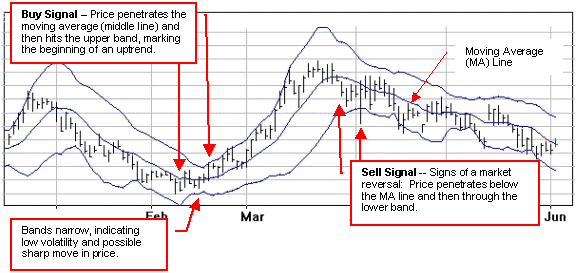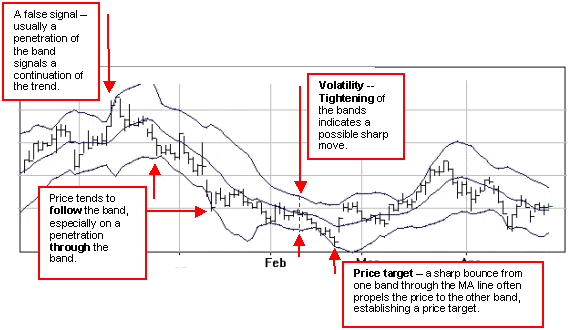Bollinger Bands
Bollinger Bands provide several useful signals, including confirmation of trend and an indication of volatility.
Overview
Bollinger Bands can provide an indication of:
- whether prices are relatively high or low
- whether current trends are likely to continue or reverse
- the volatility of a market, based on the width of the band .

Developed by John Bollinger, this technique is one of the most popular forms of envelope or channel indicator. Two winding parallel lines above and below a central moving average (MA) create a band that contains the majority of price movements within a channel. This is similar to moving average envelopes. The difference is that Bollinger Bands are also sensitive to volatility in the market. The bands spread further apart during volatile markets and come closer together during calmer markets.
Technically speaking, moving average envelopes are plotted at a fixed percentage above and below a moving average, whereas Bollinger Bands are placed two standard deviations above and below the moving average, which is usually 20 days. Using two standard deviations ensures that 95% of the price data will fall between the two outside bands.
Interpretation
John Bollinger has written that, "Trading bands are one of the most powerful concepts available to the technically based investor, but they do not, as is commonly believed, give absolute buy and sell signals based on price touching the bands. What they do answer is the perennial question of whether prices are high or low on a relative basis." He goes on to say, "It is the action of prices near the edges of the envelope that we are particularly interested in."
As with most indicators, signals generated by Bollinger Bands should be confirmed using complimentary indicators. According to Bollinger, one of the biggest mistakes in technical analysis is the multiple counting of the same information. For example, using different indicators all derived from the same series of closing prices to confirm one another.
The indicators he recommends to complement Bollinger Bands are:
- RSI or MACD -- based on price alone
- On-Balance Volume (OBV) -- combining closing prices and volume
- Money Flow -- combining price range and volume
- He recommends against using the Commodity Channel Index (CCI) for the reason above
"See the description for each of these indicators for further information."
Signals
Bollinger Bands provide the following useful signals:
Trend: when prices move outside the bands, a continuation of the current trend is implied. Strongly trending markets will often stay touching and occasionally penetrating the band for long periods. Watch for initial penetrations of a band, particularly if other indicators confirm a potential move. When the bands are unusually far apart, the current trend may be ending. When the two bands are very tight, the market may be about to initiate a new trend.
Price targets: a move that originates at one band tends to go all the way to the other band. This observation can be used projecting price targets. For example, if prices bounce off the lower band and cross above the 20 day moving average, the upper band becomes the upper price target. A crossing below the 20 day average would establish the lower band as a price target.
Volatility (width of bands): sharp price changes tend to occur after the bands tighten, as volatility lessens.
Momentum: when the price moves above or below the Bollinger band then, on a subsequent move, fails to reach the band, you can interpret this as a loss of momentum and a reversal is possible. Many times the subsequent move will reach a higher or lower price but the loss of momentum is still indicated.
